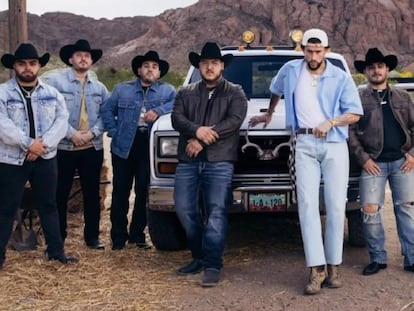Corridos and banda sweep the global charts: Is Mexican music the new reggaeton?
The so-called regional genre is reaching historic heights of popularity and is gaining international fame thanks to a new generation of young artists

Mexican regional music has carved a niche for itself in the global charts, stepping up and flexing its muscles to break down the barriers that have kept the musical macro-genre confined to the country where it was born. Seven regional songs have entered the Global Top 50 on Spotify: six corridos and one song with grupero overtones. The experts we interviewed argue that this is a historic boom, supported by the success of streaming platforms and the reinvention of traditional rhythms by new artists. The return to traditional Mexican tastes traces a positive trend that is, for the moment, continuing to grow.
“Latinos had a lot to sing, to dance, and to show, but we didn’t have the means. Now, in the digital era, I think the richness of Latin music is being rediscovered,” says David Ortega, Sony Music Mexico’s vice president of artists and repertoire. He believes that the new generations are reinventing the dozens of subgenres of regional Mexican music — such as banda, ranchera and corrido — and have breathed new life into a genre that for years has been almost exclusively for Mexican audiences. “At its heart, it’s traditional music. This new generation is reinventing it, embracing new genres, and somehow creating new sounds, and that is connecting with younger people. That’s making this a historic boom.”
Ortega has been in the music industry for 20 years, making him an authoritative voice in the business. He argues that the massive consumption of regional music has always been part of Mexicans’ musical tastes, through concerts and popular festivals. With the emergence of music streaming platforms and the development of music charts, there has been a positive trend in the regional macro-genre. Ortega sums up the point with one sentence: “The numbers are real: the scene is crossing the border.” Regional music has seen its dreams quietly coming true. Peso Pluma, a young Mexican turned musical phenomenon, overtook Bad Bunny in the charts with his hit song “Ella baila sola,” putting a whole new twist on the music scene. It was not an isolated case. Coachella — the great American music festival — took a punt on regional music by giving Grupo Firme top billing with other artists on its opening night.
The global charts have given rise to a heterogeneous mix of styles among the hits: from pop to trap to reggaeton and rap. Mario Larios, the publicist for artists Pepe and Ángela Aguilar, believes that musical tastes are paramount when it comes to understanding the success of a song. “Managing to communicate something is worthwhile, and the people who stand to gain from that are the public. You can’t fool them. The charts can be manipulated, but people are not stupid. If they don’t like it, they’re not going to listen to it,” he says. Over the years, Larios has noticed a greater professionalization and specialization of regional musicians: “[They were] people who formed a group and grew it, and then it started to work. But they had no idea of what the music industry was like. There were also people who were extremely prepared and surrounded themselves with specialists. Today it’s different. The children of these pioneers are prepared. They have studied, they know what the music business is, they know what production is, and they know what marketing is”.
Back to their roots
New Mexican artists have taken up the classic rhythms of genres such as corrido or ranchera: from singers such as Peso Pluma or Natanael Cano, with the corrido tumbado phenomenon — a variant that draws on reggaeton and rap — to Yuridia, a pop singer who turned her career around with “Qué agonía” — a ranchera in collaboration with Ángela Aguilar. In this trend, mariachi singer Rosy Arango sees a way back to the original Mexican roots. “For me [regional music] represents my country and the wonderful memories of my grandmother cooking mole for me. It is a memory of my grandparents, of my people, of my land.”

Arango sees a thing of beauty in the new generation’s search for the classics, this dialogue between new artists and the Mexican musical tradition. The rising tide of music platforms and the increasing popularity of the genre have also boosted her songs, which have maintained the same style for two decades. Arango says: “People under 30 and 20 are starting to listen to me. I keep singing the same thing. And I’m like ‘well, what’s going on?’ I haven’t changed anything, I still sing the same José Alfredo [Jiménez] songs.” The mariachi singer says that the international scene has begun to notice Mexican music knocking on the doors of success: “We are where we have always been, but I think [this trend] has also happened because we are recognizing our greatness.”
The size of the country and its geographical location represent a large market for musicians. “Mexico is one of the largest countries in the world. With the number of people living here [126.7 million], it is breaking into and increasing [the size of the music market]. We are close to the border with both North and Central America,” concludes Larios. The regional music frontier, however, also has a special presence in the United States, where there is a large population of people of Mexican origin — around 40 million, according to the U.S. State Department. Barbara Baeza, director of the BMB Convention (a bookings fair for artists), affirms that people of Mexican origin in the United States “live on homesickness,” which has caused the genre to expand over there as well. Examples are the musicians that make up the Texas-based band Grupo Frontera — which recently released Un x100to, a cumbia grupera with Puerto Rican star Bad Bunny — and the Washington trio Yahritza Y Su Esencia, whose corridos have generated more than five million listens on Spotify.
An opportunity for the industry
Baeza talks about the success of some of the more specific subgenres of regional Mexican music: the corrido, the banda and, above all, the grupero: “Right now, all the fairs, all the public events, are overrun by these types of grupero and banda styles. Unfortunately, we are not giving much importance to the Mexican genre itself, to mariachi and contemporary music.” Baeza considers that in Mexico the genres have not been differentiated enough, and tries to discuss the different ramifications the enormous regional genre has caused.
Over at Sony, Ortega notes that the label has begun to show a strong commitment to the regional market. “More than seeing it as a market opportunity, we see it as an enormous historical and cultural opportunity, which is putting all of Mexico out into the world. The record companies’ responsibility at this time is to dive in and support Mexican talent.” The vice president emphasizes that the continuing success of the Mexican macro-genre is not a passing fad and requires greater understanding. “Mexican music is a culture, and you have to grow up in it: you have to see it, take it in, have it in your blood, because the truth is that it is very important that people connect with this popular music and feel it is real.”
Ortega believes that artists retreating to the musical frameworks of their own country has become a fact: “I believe that the best way to be international is to go down to the root, the base, the origin.” In recent years, artists from other parts of the world have tried to infuse more traditional genres into their songs, such as cumbia villera mixed with reggaeton in Argentina — with the example of musician L-Gante; the introduction of flamenco tinges in the experimental albums of Spanish singer Rosalía; and the fusion of Colombian rhythms and electronica of Bogotá group Meridian Brothers.
For Sony’s vice president, the rise of Mexico’s own rhythms does not translate into a loss of U.S. musical hegemony, but rather a kind of break with the traditional market norms. “I would call it a discovery of the variety and richness of Latin music. Before the digital age, we consumed what the mass media played and what was played in discos, clubs and bars, and you stayed there. But now, when an artist uploads a song, it immediately reaches the whole world.”
Sign up for our weekly newsletter to get more English-language news coverage from EL PAÍS USA Edition
Tu suscripción se está usando en otro dispositivo
¿Quieres añadir otro usuario a tu suscripción?
Si continúas leyendo en este dispositivo, no se podrá leer en el otro.
FlechaTu suscripción se está usando en otro dispositivo y solo puedes acceder a EL PAÍS desde un dispositivo a la vez.
Si quieres compartir tu cuenta, cambia tu suscripción a la modalidad Premium, así podrás añadir otro usuario. Cada uno accederá con su propia cuenta de email, lo que os permitirá personalizar vuestra experiencia en EL PAÍS.
¿Tienes una suscripción de empresa? Accede aquí para contratar más cuentas.
En el caso de no saber quién está usando tu cuenta, te recomendamos cambiar tu contraseña aquí.
Si decides continuar compartiendo tu cuenta, este mensaje se mostrará en tu dispositivo y en el de la otra persona que está usando tu cuenta de forma indefinida, afectando a tu experiencia de lectura. Puedes consultar aquí los términos y condiciones de la suscripción digital.
More information
Archived In
Últimas noticias
Maduro to be tried in the US for narcoterrorism and corruption
Maps of the US attack on Venezuela: Targets, airspace and deployed fleet
Venezuelans in exile: ‘This could be the end of a very dark chapter for Venezuela, but also the beginning of a time of uncertainty’
Key points of the military attack on Venezuela: Early morning bombings and a ‘captured’ president
Most viewed
- Alain Aspect, Nobel laureate in physics: ‘Einstein was so smart that he would have had to recognize quantum entanglement’
- David King, chemist: ‘There are scientists studying how to cool the planet; nobody should stop these experiments from happening’
- Mexico completes its trade shift with the entry into force of tariffs on China and countries without trade agreements
- Reinhard Genzel, Nobel laureate in physics: ‘One-minute videos will never give you the truth’
- Oona Chaplin: ‘I told James Cameron that I was living in a treehouse and starting a permaculture project with a friend’











































